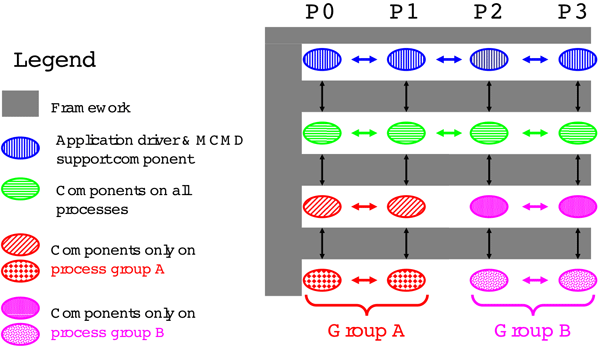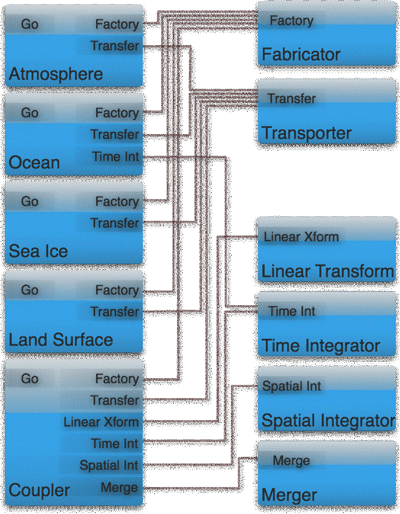Beyond the core specification, a number of software tools have been developed that assist users in developing HPC applications around component technology. These tools, developed both through the TASCS Center, and through CCA collaborators, provide interoperability between programming languages, assistance with packing and deployment, and tools for performance analysis. There also exists a handful of different CCA-compliant frameworks that target different operating environments. A few of these tools are described here and additional information can be found at the CCA Forum home page.
Babel (pronounced babble)8 addresses the language interoperability problem using a Scientific Interface Definition Language (SIDL) that provides the ability to interact between programming languages and platforms, while addressing the unique needs of parallel scientific computing. Given a SIDL description that describes the calling interface (but not the implementation) of a particular software library, Babel generates glue code that allows software implemented in one supported language to be called from any other supported language. SIDL supports complex numbers and dynamic multi-dimensional arrays as well as parallel communication directives that are required for parallel distributed components. SIDL also provides other common features that are generally useful for software engineering, such as enumerated types, symbol versioning, and name space management, and employs an object-oriented inheritance model similar to Java. Babel provides a code splicing capability that preserves old edits during the regeneration of implementation files after modifications to the SIDL source.
Babel recently added a remote method invocation that provides a consistent mechanism to communicate between objects regardless of where they are located. This model provides a simpler and more consistent object-oriented programming model than CORBA or COM, and provides an API for third-party plug-ins to customize the underlying communication model. A simple TCP/IP protocol is provided that outperforms both CORBA and Web Services. Babel RMI fills a niche in “short-haul” distributed computing - within a machine room, or even in a single machine with concurrent MPI runs.
Ccaffeine9 is the main CCA framework implementation for HPC parallel computing and it supports the component analogs of both the single program/multiple data (SPMD) and multiple program/multiple data (MPMD) parallel programming models. We refer to these as single or multiple component/multiple data (SCMD or MCMD) models. Figure 2 depicts the SCMD case; each process is loaded with the same set of components wired together in the same way. Interactions among components within a given process (vertical direction) take place through the normal CCA means - through Ports. Interactions within a parallel component (called a parallel cohort) take place via the parallel programming model that the component uses (typically MPI). “Diagonal'” interactions - between component A on one process and component B on another process - are not prohibited by the CCA, but are currently not supported in Ccaffeine.

Bocca is a system for creating, managing, and deploying CCA-based components. Bocca can create components, define ports and interfaces, and manage the build system for the resulting component. Bocca is a new addition to the CCA tool suite, but promises to dramatically simplify the process of creating a component from scratch and subsequently maintaining it.
Performance Monitoring and Tuning. TAU is a robust and portable measurement interface and system for software performance evaluation. Using SIDL to describe TAU's measurement API, Babel has enabled access to TAU across all supported languages. CCA/Babel has also enabled incorporation of dynamic selection of measurement options into the TAU performance evaluation tools. Users can choose from a variety of measurement options interactively at runtime, without re-compilation of applications. Proxy components are automatically generated to mirror a component's interface, allowing dynamic interposition of proxies between callers and callees, via hooks into the intermediate Babel communication layer. Such inter-component interaction measurements can correlate performance to application parameters, used for constructing more sophisticated performance models.

Components for Parallel Coupling. Multiphysics and multiscale models face a formidable obstacle: the parallel coupling problem. Parallel coupling involves the description, transfer, and transformation of distributed data. We are developing a set of CCA components (the Parallel Coupling Infrastructure, or PCI Toolkit) that leverage successful parallel coupling technology - the Model Coupling Toolkit - to simplify the process of remapping data between disparate discretizations and processor mappings.
Additional tools. In addition to these tools and software frameworks, the TASCS Center maintains additional component-based software for developing HPC applications on CCA technology. A graphical user interface allows interactive construction and monitoring of HPC applications. CCA-lite is a slimmed down version of the CCA specification designed for statically-linked components that are written in C, C++ and/or Fortran. Additional frameworks, such as the SCIJump distributed/parallel framework from Utah and the LegionCCA Grid-based framework from SUNY Binghamton, also provide alternative deployment vehicles for CCA components.






